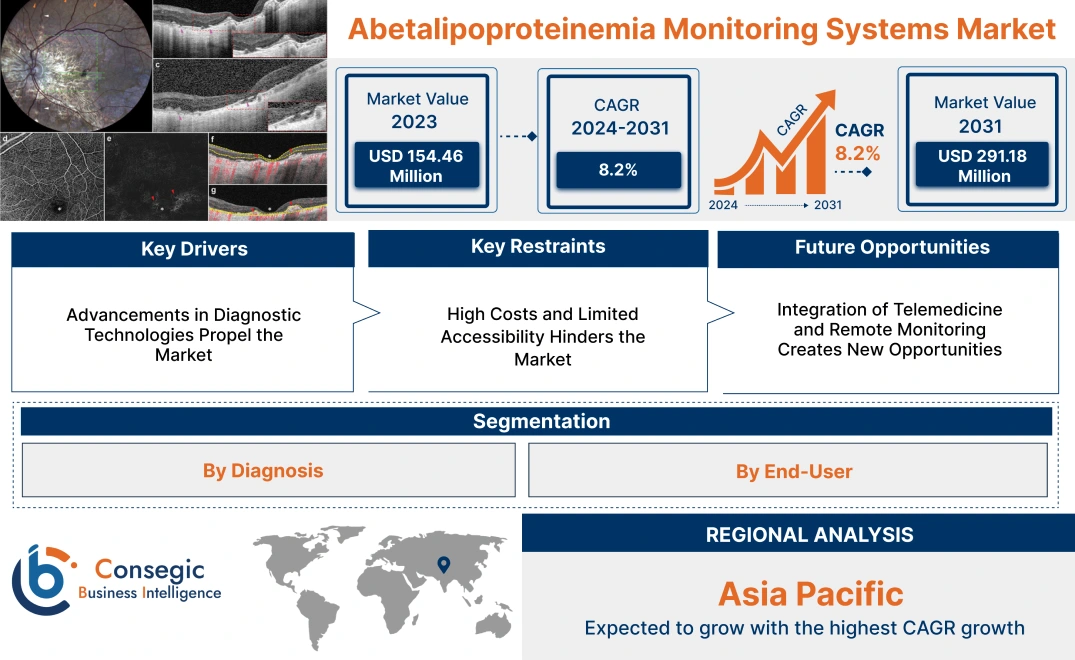- Summary
- Table Of Content
- Methodology
Abetalipoproteinemia Monitoring Systems Market Size:
Abetalipoproteinemia Monitoring Systems Market size is estimated to reach over USD 291.18 Million by 2031 from a value of USD 154.46 Million in 2023 and is projected to grow by USD 164.45 Million in 2024, growing at a CAGR of 8.2% from 2024 to 2031.
Abetalipoproteinemia Monitoring Systems Market Scope & Overview:
Abetalipoproteinemia monitoring systems are specialized medical devices designed to track and manage abetalipoproteinemia, a rare genetic disorder that impairs the absorption of dietary fats, cholesterol, and fat-soluble vitamins. This condition leads to malnutrition, neurological issues, and vision problems. These monitoring systems help in tracking lipid levels, fat-soluble vitamin deficiencies, and other health parameters critical to managing the disease. By providing accurate and continuous data, these systems assist healthcare professionals in adjusting treatment plans and improving patient outcomes. With advancements in diagnostic technologies and growing awareness of rare genetic conditions, healthcare providers are adopting these systems to enhance patient care. Hospitals, specialized clinics, and research institutions are key end-users of these monitoring systems.
Abetalipoproteinemia Monitoring Systems Market Dynamics - (DRO) :
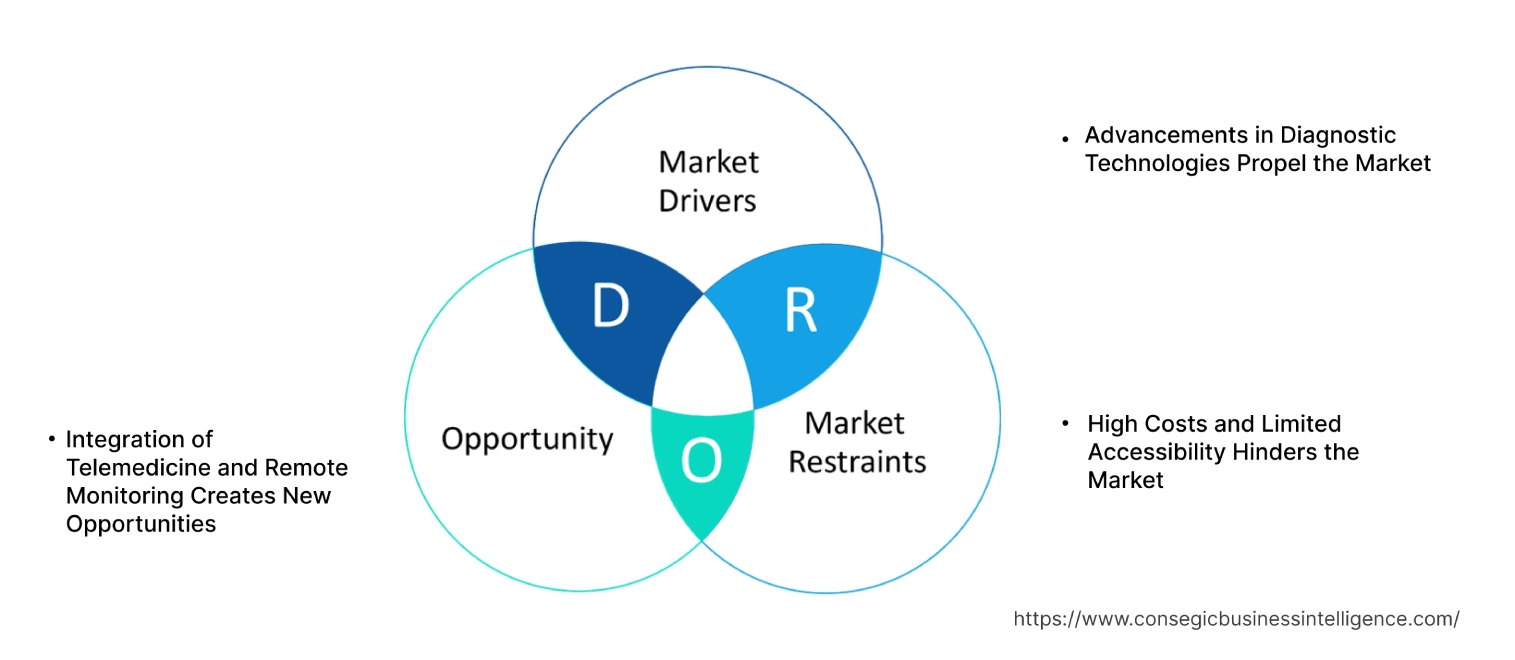
Key Drivers:
Advancements in Diagnostic Technologies Propel the Market
Recent advancements in diagnostic technologies have significantly enhanced the ability to monitor and manage abetalipoproteinemia. Innovations such as molecular genetic testing and advanced blood assays enable early detection and continuous monitoring of lipid levels and fat-soluble vitamin deficiencies. These technologies facilitate personalized treatment plans, improving patient outcomes and quality of life. The integration of these diagnostic tools into routine clinical practice has increased the demand for specialized monitoring systems tailored to this rare condition. Thus, the market trends analysis concludes that the aforementioned factors drive the abetalipoproteinemia monitoring systems market growth.
Key Restraints :
High Costs and Limited Accessibility Hinders the Market
The high costs associated with specialized monitoring systems pose a significant barrier to abetalipoproteinemia monitoring systems market demand. Advanced diagnostic tools and continuous monitoring devices often require substantial investment, making them less accessible, especially in low-income regions. Additionally, the rarity of the condition means that healthcare providers may lack the experience and resources to effectively utilize these systems, further limiting their implementation. This financial and logistical challenge hinders the abetalipoproteinemia monitoring systems market growth and the ability to provide optimal care to all patients.
Future Opportunities :
Integration of Telemedicine and Remote Monitoring Creates New Opportunities
The integration of telemedicine and remote monitoring technologies presents a promising opportunity for the market. Remote monitoring devices can track patients' lipid profiles and nutritional status in real time, allowing healthcare providers to adjust treatment plans promptly. Telemedicine platforms facilitate regular consultations without the need for frequent in-person visits, which is particularly beneficial for patients in remote or underserved areas. This approach not only enhances patient engagement and adherence to treatment but also reduces healthcare costs and resource utilization. Embracing these technologies can expand access to specialized care and improve outcomes for individuals with abetalipoproteinemia. Thus, in turn, creating lucrative abetalipoproteinemia monitoring systems market opportunities.
Abetalipoproteinemia Monitoring Systems Market Segmental Analysis :
By Diagnosis:
Based on diagnosis, the market is segmented into molecular genetic testing and blood testing.
The molecular genetic testing segment accounted for the largest revenue share of the total abetalipoproteinemia monitoring systems market share in 2023.
- Molecular genetic testing plays a crucial role in diagnosing abetalipoproteinemia, a rare genetic disorder. This testing method identifies mutations in the MTTP gene, which is responsible for the condition.
- The increasing emphasis on early and accurate diagnosis of genetic disorders has driven the demand for molecular genetic testing.
- It is particularly important in family screening and in guiding treatment strategies for individuals affected by this condition.
- With the growing advancements in genetic testing technologies, such as next-generation sequencing (NGS), the molecular genetic testing segment has become the most reliable method for diagnosing abetalipoproteinemia.
- Thus, the growing trend towards molecular genetic testing is due to its accuracy in identifying gene mutations responsible for abetalipoproteinemia, in turn, boosting abetalipoproteinemia monitoring systems market demand.
The blood testing segment is anticipated to register the fastest CAGR during the forecast period.
- Blood testing is essential in monitoring the levels of fats, cholesterol, and fat-soluble vitamins in individuals with abetalipoproteinemia.
- It provides crucial information on the patient's lipid profile, which is critical for managing and tracking the progression of the disease.
- The growing focus on continuous monitoring of lipid levels to prevent complications such as neurological issues and gastrointestinal problems has spurred the demand for blood testing.
- As more healthcare providers emphasize regular monitoring to improve patient outcomes, the blood testing segment is expected to witness rapid growth.
- Hence, the market trends analysis shows that blood testing is expected to grow rapidly due to its essential role in monitoring lipid levels and overall disease management, boosting the abetalipoproteinemia monitoring systems market trends.
By End-User:
Based on end-users, the market is segmented into hospitals, diagnostic laboratories, research institutes, specialty clinics, and others.
The hospitals segment accounted for the largest revenue share of 35.67% of the overall abetalipoproteinemia monitoring systems market share in 2023.
- Hospitals remain the primary providers of abetalipoproteinemia diagnostics and monitoring services.
- These facilities offer comprehensive care, including genetic counseling, advanced diagnostic tools, and long-term monitoring of patients with abetalipoproteinemia.
- The availability of specialized healthcare professionals and the infrastructure for conducting both molecular genetic and blood tests make hospitals the preferred choice for diagnosing and managing this rare condition.
- Therefore, the segmental trends analysis depicts that the hospitals lead the market due to their comprehensive diagnostic capabilities, infrastructure, and specialized care for patients, driving the abetalipoproteinemia monitoring systems market expansion.
The diagnostic laboratories segment is anticipated to register the fastest CAGR during the forecast period.
- Diagnostic laboratories are gaining traction due to their expertise in performing both genetic and biochemical tests for abetalipoproteinemia.
- Laboratories equipped with advanced genetic testing technologies are becoming critical partners in the early detection of this genetic disorder.
- With the growing trend of outsourcing complex genetic testing to specialized labs and the increasing accessibility of laboratory services, this segment is expected to grow rapidly.
- Additionally, diagnostic laboratories offer faster turnaround times for test results, making them a preferred option for healthcare providers focused on timely diagnosis.
- Thus, the segmental trends analysis concludes that diagnostic laboratories are expected to grow rapidly as they become key providers of advanced genetic and biochemical testing, boosting the abetalipoproteinemia monitoring systems market trends.
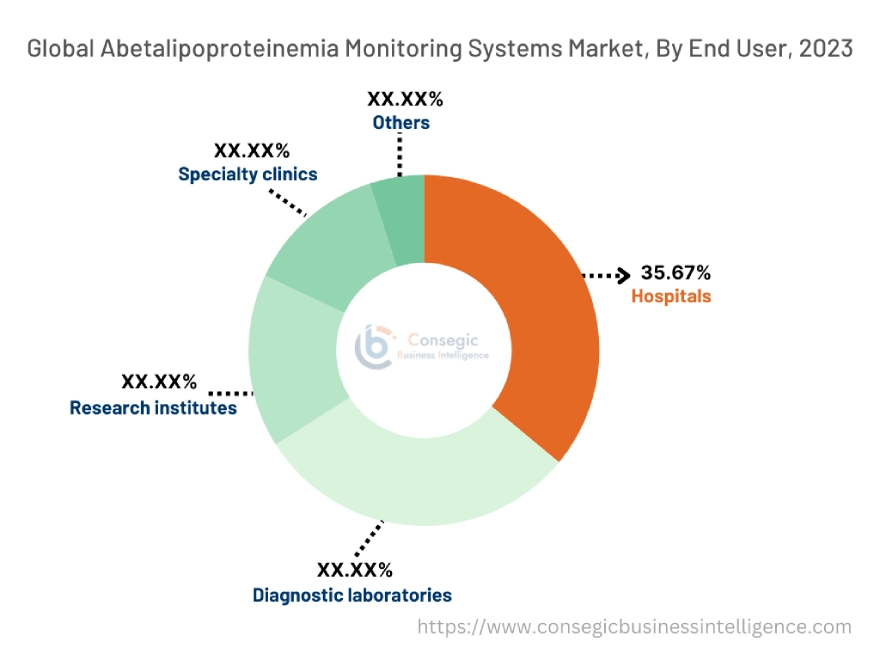
Regional Analysis:
The regions covered are North America, Europe, Asia Pacific, the Middle East and Africa, and Latin America.
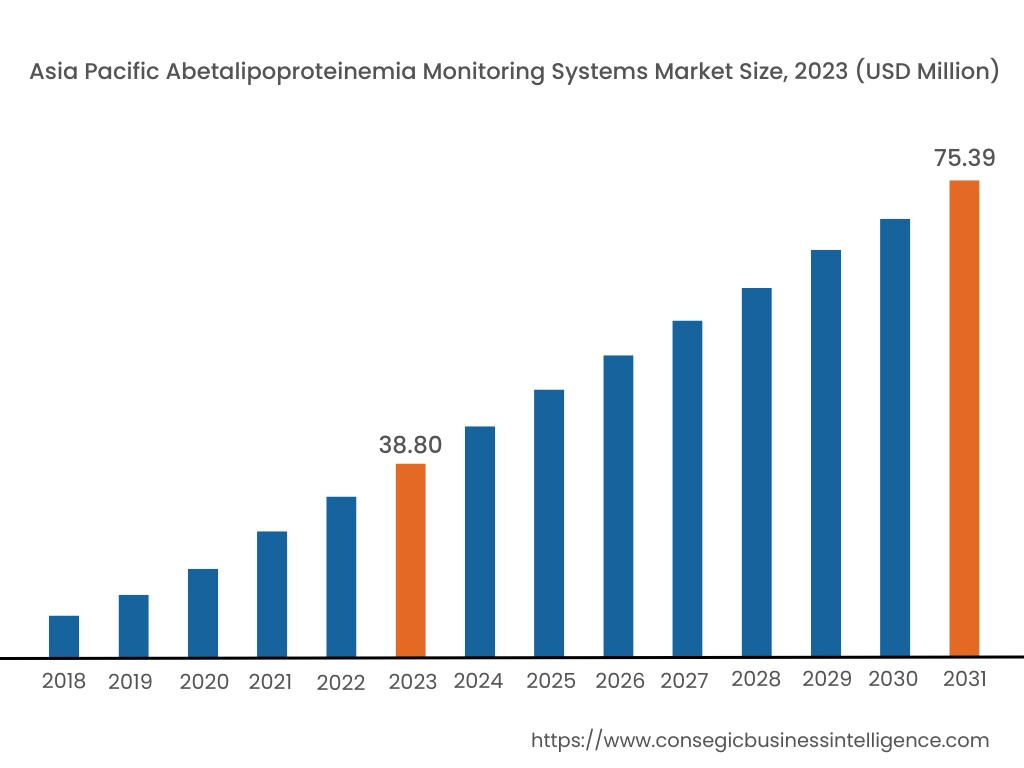
Asia Pacific region was valued at USD 38.80 Million in 2023. Moreover, it is projected to grow by USD 41.41 Million in 2024 and reach over USD 75.39 Million by 2031. Out of this, China accounted for 29.6% of the total market share. As per the abetalipoproteinemia monitoring systems market analysis, China, Japan, and India are leading the region, with improving healthcare access and a rising focus on early detection and continuous monitoring of rare conditions. Government initiatives aimed at expanding healthcare infrastructure and supporting rare disease management bolster the market's prospects. However, limited access to specialized monitoring tools in rural areas and a lack of widespread awareness remain significant challenges.
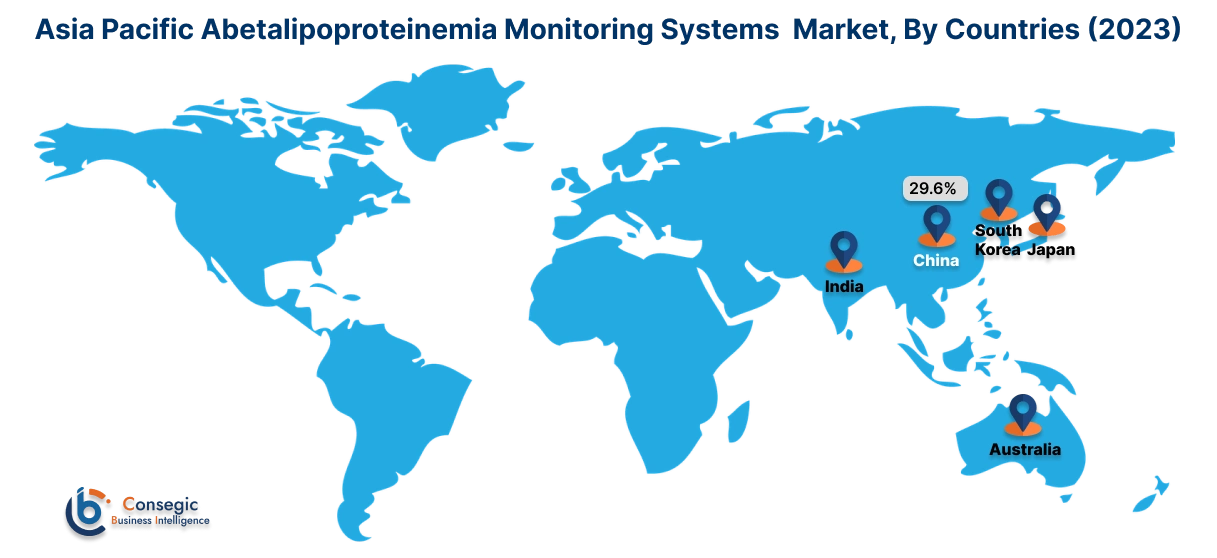
North America leads the market, largely due to its advanced healthcare infrastructure and the increasing focus on rare disease management. The U.S. plays a key role, with growing research efforts to improve diagnostic and monitoring tools for rare genetic disorders like abetalipoproteinemia. The presence of specialized medical centers and strong support for genetic research further strengthens market growth. However, the high cost of specialized monitoring systems and limited patient populations challenge broader adoption.
Europe holds a considerable portion of the market, driven by government initiatives and healthcare policies supporting the treatment of rare diseases. Countries such as Germany, the UK, and France are key players, offering advanced diagnostic and monitoring services for genetic conditions. The presence of dedicated healthcare programs for rare diseases and collaboration between research institutions and healthcare providers enhances the region's capacity to monitor abetalipoproteinemia. However, strict regulatory requirements and the high cost of advanced systems could slow abetalipoproteinemia monitoring systems market expansion.
The abetalipoproteinemia monitoring systems market analysis shows that the Middle East & Africa region is experiencing gradual growth in the market, particularly in countries like Saudi Arabia, the UAE, and South Africa. Growing healthcare investments and improving diagnostic capabilities for rare diseases are boosting the uptake of monitoring systems. The region's efforts to enhance healthcare services and build specialized centers for genetic disorders contribute to market growth. However, economic disparities and the limited availability of advanced monitoring technologies in less developed areas continue to hinder abetalipoproteinemia monitoring systems market development.
Latin America is an emerging market, with Brazil and Mexico leading the region. Efforts to improve healthcare access, along with rising awareness of rare diseases, are supporting the adoption of monitoring systems for abetalipoproteinemia. Government initiatives to strengthen healthcare services and promote research into genetic disorders provide abetalipoproteinemia monitoring systems market opportunities. However, economic challenges and inconsistent healthcare infrastructure across the region may restrict the widespread use of advanced monitoring systems.
Top Key Players & Market Share Insights:
The abetalipoproteinemia monitoring systems market is highly competitive with major players providing treatments to the national and international markets. Key players are adopting several strategies in research and development (R&D), product innovation, and end-user launches to hold a strong position in the global abetalipoproteinemia monitoring systems market. Key players in the abetalipoproteinemia monitoring systems industry include –
- Medtronic plc (Ireland)
- Thermo Fisher Scientific Inc. (USA)
- Bio-Rad Laboratories, Inc. (USA)
- Siemens Healthineers AG (Germany)
- Roche Diagnostics (Switzerland)
- PerkinElmer, Inc. (USA)
- Agilent Technologies, Inc. (USA)
- Danaher Corporation (USA)
- QIAGEN N.V. (Netherlands)
- Illumina, Inc. (USA)
Recent Industry Developments :
Product Launches:
- In March 2024, UTMHealthcare and Somml Health launched NuLink Health, a system that uses remote monitoring to manage high-risk patients between visits, reducing hospital readmissions and costs with real-time data integration.
- In May 2022, Geisinger launched ConnectedCare365 by Noteworth, a virtual care platform that helps patients with chronic conditions track health metrics and stay connected with care teams, aiming to prevent ER visits and hospitalizations.
Abetalipoproteinemia Monitoring Systems Market Report Insights :
| Report Attributes | Report Details |
| Study Timeline | 2018-2031 |
| Market Size in 2031 | USD 291.18 Million |
| CAGR (2024-2031) | 8.2% |
| By Diagnosis |
|
| By End-User |
|
| By Region |
|
| Key Players |
|
| North America | U.S. Canada Mexico |
| Europe | U.K. Germany France Spain Italy Russia Benelux Rest of Europe |
| APAC | China South Korea Japan India Australia ASEAN Rest of Asia-Pacific |
| Middle East and Africa | GCC Turkey South Africa Rest of MEA |
| LATAM | Brazil Argentina Chile Rest of LATAM |
| Report Coverage |
|
Key Questions Answered in the Report
How big is the Abetalipoproteinemia Monitoring Systems Market? +
In 2023, the Abetalipoproteinemia Monitoring Systems market was USD 154.46 Million.
What will be the potential market valuation for the Abetalipoproteinemia Monitoring Systems by 2031? +
In 2031, the market size of Abetalipoproteinemia Monitoring Systems is expected to reach USD 291.18 million.
What are the segments covered in the Abetalipoproteinemia Monitoring Systems market report? +
The diagnosis and end-user industry are the segments covered in this report.
Who are the major players in the Abetalipoproteinemia Monitoring Systems market? +
Medtronic plc (Ireland), Thermo Fisher Scientific Inc. (USA), Bio-Rad Laboratories, Inc. (USA), Siemens Healthineers AG (Germany), Roche Diagnostics (Switzerland), PerkinElmer, Inc. (USA), Agilent Technologies, Inc. (USA), Danaher Corporation (USA), QIAGEN N.V. (Netherlands), Illumina, Inc. (USA) are the major players in the Abetalipoproteinemia Monitoring Systems market.
